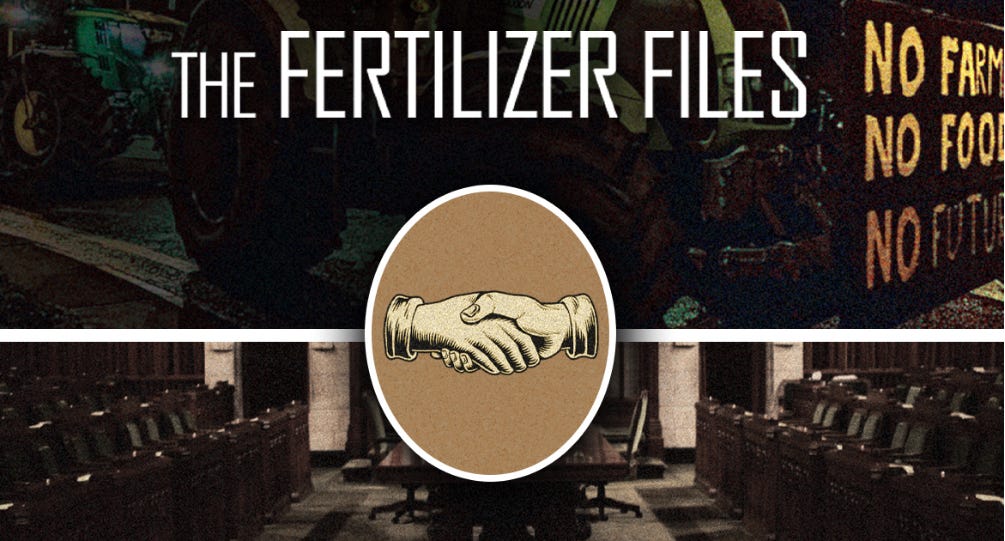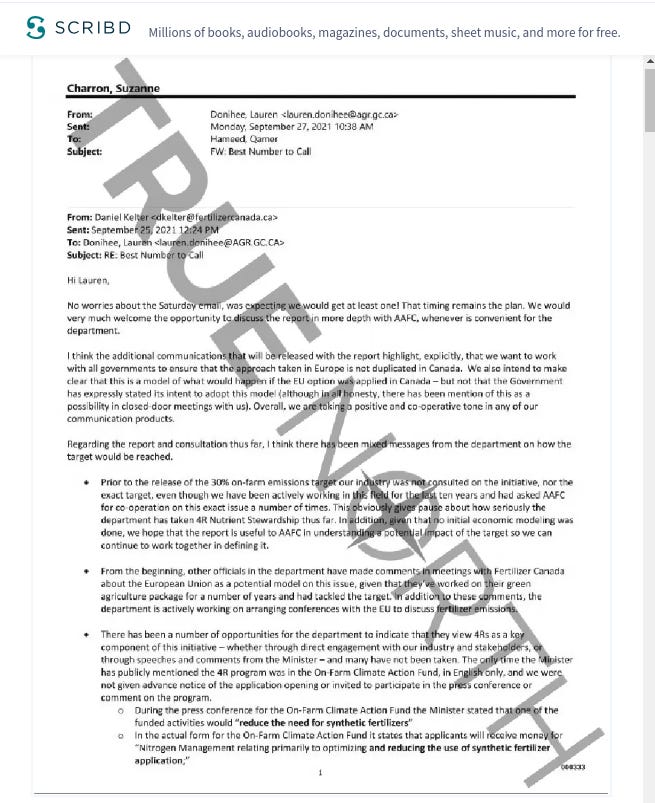EXCLUSIVE: Ottawa Considered Following Europe’s Riot-Causing Fertilizer Rules
Documents obtained by True North as part of its ongoing investigative series into the fertilizer emission reduction scheme..
One-time or recurring donations can be made through Ko-Fi:
By Cosmin Dzsurdzsa February 1, 2023
This is the final part of the Fertilizer Files, a 3-part series on what internal government documents show about the Trudeau Liberals’ push to reduce fertilizer emissions. Read part 1 here and part 2 here.
While modeling its agriculture emissions reduction plan, Ottawa considered following in the footsteps of the European Union – which has asked member states to introduce policies to reduce fertilizer use altogether. The controversial policy, when applied in countries like the Netherlands, has led to widespread protests, tractor convoys and clashes with authorities.
Documents obtained by True North as part of its ongoing investigative series into the fertilizer emission reduction scheme show that along the way the government was closely aligning its approach with the European strategy.
About a year after the voluntary federal target was first announced, the industry group Fertilizer Canada raised their concerns that Ottawa would follow in the footsteps of the EU’s “Farm to Fork Strategy” (F2F), which mandates a 20% wholesale reduction in use of fertilizer among 27 other climate-oriented actions that include a 10% reduction in farmland.
In an email to the Ministry of Agriculture dated to June 21, 2021, the organization’s representative went on to urge that “the approach taken in Europe is not duplicated” in Canada.
“I think the additional communications that will be released with the report highlight, explicitly, that we want to work with all governments to ensure that the approach taken in Europe is not duplicated in Canada,” said senior manager of government relations Daniel Kelter.
Fertilizer Canada also cited “closed-door meetings” with the government where the possibility of taking the EU approach was considered.
“From the beginning other officials in the department have made comments in meetings with Fertilizer Canada about the European Union as a potential model on this issue.”
According to internal memos, Fertilizer Canada’s concerns were well-founded. One June 2021 briefing described the European Union’s policy framework as “an opportunity (for Canada) to align itself with the EU on a shared commitment to sustainable agriculture.”
A copy of a speech delivered by Agriculture Minister Marie Claude-Bibeau that same year as part of a sustainable agriculture webinar with European counterparts went even further, describing Canada’s measures as “very closely aligned” with “the fertilizer reduction target in the EU’s Farm to Fork strategy.”
Prompted by the overarching F2F approach, the Dutch government unveiled its ambitious plan to cut nitrogen emissions by a whopping 50% via a €7.5 billion farm buyout scheme. The move immediately led to nationwide protests from farmers and even the resignation of Netherland’s agricultural minister at the time.
In the same email, Kelter went on to explain how the fertilizer industry “was not consulted” on the 30% emission goal “even though we have been actively working in this field for the last ten years and had asked (Agriculture Canada) for co-operation on this exact issue a number of times.”
Throughout the consultation process Fertilizer Canada has called on the government to adopt an “emission intensity” reduction target instead of an “absolute emission” cut – which has been Ottawa’s preferred measure. Farmers groups have argued that cutting greenhouse gasses emitted relative to the production of a bushel is a much less risky target than an absolute reduction.
To achieve these goals the group has advocated for its 4R Nutrient Stewardship program which calls on farmers to apply fertilizer at the “right source, right rate, right time and right place” – an effort which the federal government has expressed endorsement of.
The Fertilizer Canada representative also raised concerns about how deputy minister of agriculture Chris Forbes allegedly claimed during a Canadian Agri-Food Policy Institute “Big Forum Webinar Series” that the imperative was to “reduce fertilizer use” while maintaining competitiveness – despite vehement denials elsewhere by the department that a wholesale fertilizer reduction was not the plan.
“(The deputy minister said) the imperative is to find a way to do both – reduce fertilizer use without impairing the competitiveness of the sector,” quoted Kelter.
Soon after the exchange Fertilizer Canada went public with a shocking report showing that should the Canadian government follow in the EU’s footsteps and require a reduction in fertilizer use as had been floated it could lead to a projected production loss of billions each year for farmers.
“The estimated lost production has significant effects on Canada’s ability to fill domestic processing capacity (e.g., canola crushing facilities) as well as export capacity. Assuming that domestic capacity will be filled first, it is estimated that by 2030 most Canadian exports of canola will not exist,” the report Implications of a Total Emissions Reduction Target on Fertilizer explains.
As True North reported in the first part of this series, the government has considered more forceful regulatory measures as future “policy options.”
After catching wind of the report’s release in the fall of 2021, senior Agriculture Canada officials were already rallying their troops to run a tight media operation and “develop responsive media lines once we become aware of the content” a Sept. 23, 2021 email from Agriculture Canada director general Donald Boucher shows.
Instead of addressing the concerns expressed by Fertilizer Canada and others, the controlled media line continued for months as a Nov. 4 2021 email from senior communications advisor Kilee Mackay stated: “We’ll need to make sure there are 2-3 tough Qs on environment in the Q&A (i.e. environmental targets and impacts it may have on sector, methane, fertilize issue, etc.) Answer should be focusing on (the minister’s) language.”
True North reached out to Agriculture Canada to inquire about the current status of the fertilizer reduction program but did not receive a response.
Source: tnc.news
Related articles:
Health Canada Initially Created For Population Control Measures
More COVID Internment Camps are Coming to Canada
The Hidden History of the Revived Roman Empire
A Sinister Force Behind Historical Conflicts, Global Agendas, Revolutions and








Starvation is a proven tactic of Communist Gangster thieves.
"Fertilizer Emissions" ? 🙄
What the Hell is this kaka-brained nonsense?